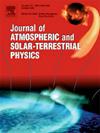通过分析相关的行星际II型太阳射电暴和太阳高能粒子事件,评估可能引起日冕物质抛射的空间天气
IF 1.9
4区 地球科学
Q3 GEOCHEMISTRY & GEOPHYSICS
Journal of Atmospheric and Solar-Terrestrial Physics
Pub Date : 2025-07-24
DOI:10.1016/j.jastp.2025.106579
引用次数: 0
摘要
本研究通过分析太阳周期24的一段时间内39米制II型太阳射电暴与十米-赫米(DH)对偶物,探讨了日冕物质抛射(cme)的空间天气影响。为了最小化投影效应,只考虑远离太阳盘中心(中心子午线距离在60°和90°之间)的边缘日冕物质抛射。这些事件被分为三组:(i)所有有DH对应的度量型II型爆发(m-DH), (II)伴随太阳高能粒子(SEP)事件(m-DH-SEP), (iii)没有SEP事件(m-DH- nonsep)。对CME参数的分析表明,与m-DH-NonSEP事件(平均速度为333 km/s)相比,m-DH-SEP事件的CME速度更快(平均速度为1203 km/s),范围更广。此外,光晕cme的比例在各组中有所增加:m-DH- nonsep (62.5%), m-DH(74.3%)和m-DH- sep(93%)。强正相关(Pearson’s CC = 0.76;日冕抛射速度与SEP事件的对数峰值强度之间的SEcc=0.18)。值得注意的是,在StonyHurst坐标下,87%的m-DH-SEP事件起源于西半球,与地球的良好磁连性一致。进一步的分析表明,62.5%的西半球公制II型爆发与地球上的DH对应,而没有DH对应的只有13%。这些发现证实了与DH型爆发相关的快速和广泛的日冕物质抛射对高能粒子的加速是有效的,强调了DH型爆发作为SEP事件指标的重要性及其在空间天气预报中的相关性。本文章由计算机程序翻译,如有差异,请以英文原文为准。
An assessment of potentially space weather causing CMEs through analysis of associated interplanetary type II solar radio bursts and solar energetic particle events
This study investigates the space weather implications of coronal mass ejections (CMEs) by analyzing 39 metric type II solar radio bursts with decametric–hectometric (DH) counterparts during a segment of Solar Cycle 24. To minimize projection effects, only limb CMEs originating far from the solar disk center (central meridian distances between and ) were considered. The events were categorized into three groups: (i) all metric type II bursts with DH counterparts (m-DH), (ii) those accompanied by solar energetic particle (SEP) events (m-DH-SEP), and (iii) those without SEP events (m-DH-NonSEP). Analysis of CME parameters revealed that m-DH-SEP events are associated with faster (average speed of 1203 km/s) and wider CMEs compared to m-DH-NonSEP events (average speed of 333 km/s). Additionally, the fraction of halo CMEs increased across the groups: m-DH-NonSEP (62.5%), m-DH (74.3%), and m-DH-SEP (93%). A strong positive correlation (Pearson’s CC = 0.76; ) was found between CME speeds and the logarithmic peak intensity of SEP events. Notably, 87% of m-DH-SEP events originated from the western hemisphere in StonyHurst coordinates, consistent with favorable magnetic connectivity to Earth. Further analysis indicated that 62.5% of western hemisphere metric type II bursts with DH counterparts were followed by SEPs at Earth, compared to only 13% without DH counterparts. These findings confirm that fast and wide CMEs associated with DH type II bursts are effective in accelerating energetic particles, underscoring the significance of DH type II bursts as indicators of SEP events and their relevance in space weather forecasting.
求助全文
通过发布文献求助,成功后即可免费获取论文全文。
去求助
来源期刊

Journal of Atmospheric and Solar-Terrestrial Physics
地学-地球化学与地球物理
CiteScore
4.10
自引率
5.30%
发文量
95
审稿时长
6 months
期刊介绍:
The Journal of Atmospheric and Solar-Terrestrial Physics (JASTP) is an international journal concerned with the inter-disciplinary science of the Earth''s atmospheric and space environment, especially the highly varied and highly variable physical phenomena that occur in this natural laboratory and the processes that couple them.
The journal covers the physical processes operating in the troposphere, stratosphere, mesosphere, thermosphere, ionosphere, magnetosphere, the Sun, interplanetary medium, and heliosphere. Phenomena occurring in other "spheres", solar influences on climate, and supporting laboratory measurements are also considered. The journal deals especially with the coupling between the different regions.
Solar flares, coronal mass ejections, and other energetic events on the Sun create interesting and important perturbations in the near-Earth space environment. The physics of such "space weather" is central to the Journal of Atmospheric and Solar-Terrestrial Physics and the journal welcomes papers that lead in the direction of a predictive understanding of the coupled system. Regarding the upper atmosphere, the subjects of aeronomy, geomagnetism and geoelectricity, auroral phenomena, radio wave propagation, and plasma instabilities, are examples within the broad field of solar-terrestrial physics which emphasise the energy exchange between the solar wind, the magnetospheric and ionospheric plasmas, and the neutral gas. In the lower atmosphere, topics covered range from mesoscale to global scale dynamics, to atmospheric electricity, lightning and its effects, and to anthropogenic changes.
 求助内容:
求助内容: 应助结果提醒方式:
应助结果提醒方式:


